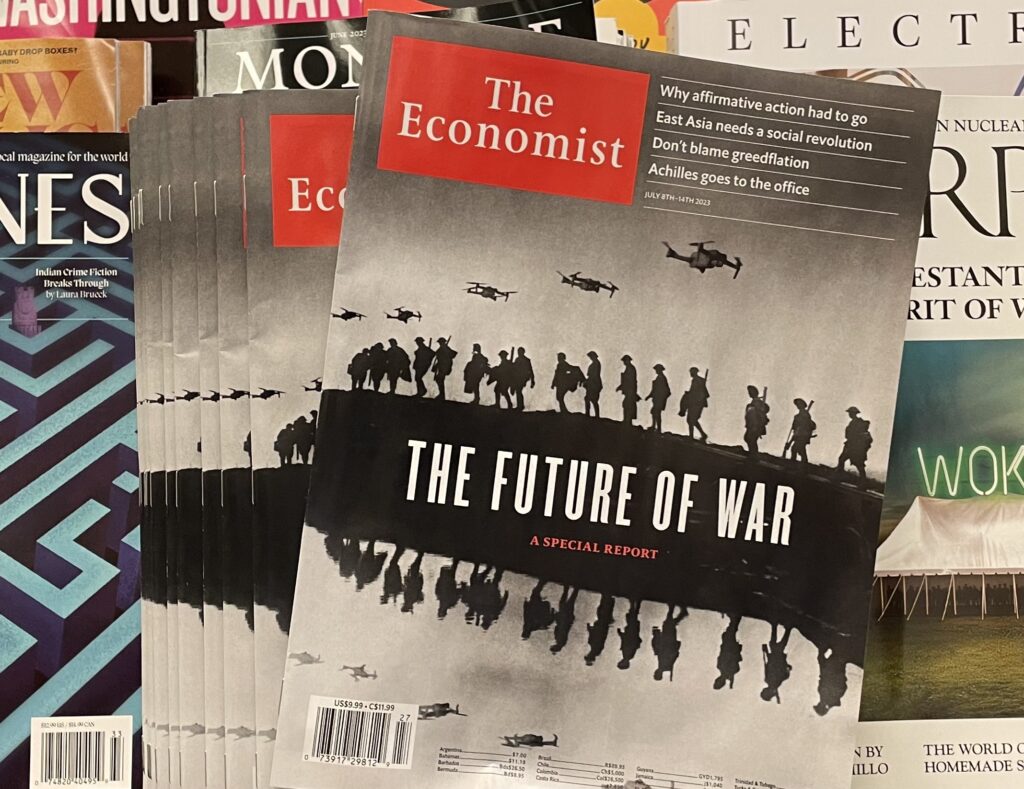“Someday they’ll give a war,
Carl Sandburg
and nobody will come.”
In this four-minute PeaceTalks video, six of our fellow riders on Earth help set the tone for each of us to end war.
Each of us, positively contributing to peace…
While all of us find ways to work together to build peace with equal respect and understanding for each stakeholder – such as this recent Middle East Peace Dialogue at Yale University, concentrating on day-after solutions to the October 7 attacks. This is waging peace at its best.

“Peace worldwide starts from inside!”
Only when an ideal of peace is born in the minds of the peoples will the institutions set up to maintain this peace effectively fulfill the function expected of them.
~ Dr. Albert Schweitzer
So let us dedicate ourselves like Einstein did when he said,
‘I am not only a pacifist but a militant pacifist. I am willing to fight for peace. Nothing will end war unless the people themselves refuse to go to war.’
Nobel Peace Prize acceptance speech 1953
So how exactly can humanity at last end
the scourge of war?
How do we meet such a seemingly impossible challenge, particularly in the face of the cynic, the terrorist and the fascist, who will always be among us?
In the words of another Nobel Peace Prize recipient, Dag Hammarskjöld, “Our work for peace must begin within the private world of each one of us.”
And from there it must flow into dramatic enlightenment across the continents, fueled by the natural and deep dedication of the vast majority of humankind towards living in peace.
Highlights
- What You Can Do Now
- Inspirational Peace Songs
- Ferdinand still sets an example
Imagine a creative groundswell of hundreds of millions of us demanding of ourselves and our leaders that we reject the monologues of violence and war, that we commit with whole-hearted resolve to dialogues of peace.
To help create such a groundswell, The Humanity Initiative has decided to foster community gatherings worldwide dedicated to enduring peace, to creating this new voice of humanity. We are working on design and content now. If you would like to volunteer, please email us at: peace@humanity.org.
Opportunities for action abound within our neighborhoods, communities, villages, savannahs, or city blocks. Come together, for example, in the ancient and relaxing tradition of sharing a cup of tea while custom designing your community’s peace mission. Listen, trade stories, see into each other’s eyes and hearts while considering the challenges and cross-currents of the day. Not least, better understand our past and investigate our future, allowing us to rediscover and rekindle ways to live and let live.
Help all us foster enduring peace with the creation of tens of thousands of such gatherings across the continents!
For easy inspiration, consider President John F. Kennedy sixty years ago reminding the world that ending war is not only necessary but possible!
198 methods of non-violent action
Jamila Raqib, born in Afghanistan, convincingly states the case for making violence obsolete in her 2016 TED talk. She also references this list of 198 profoundly possible methods of non-violent action, gifted to humanity by the Albert Einstein Institution and its founder, Dr. Gene Sharp.
As you will see below, they are classified into three broad categories: nonviolent protest and persuasion, noncooperation (social, economic and political), and nonviolent intervention. A description and historical examples of each can be found in volume two of The Politics of Nonviolent Action by Dr. Sharp. In 2012, he was a recipient of the Right Livelihood Award for “developing and articulating the core principles and strategies of nonviolent resistance and supporting their practical implementation in conflict areas around the world”
Undoubtedly, a large number of additional methods have already been used but have not been classified. Not least, a multitude of methods will be invented in the future that arise from new technologies and the determined creativity of younger generations. Over to you!
The methods of nonviolent protest and persuasion
FORMAL STATEMENTS
1. Public Speeches
2. Letters of opposition or support
3. Declarations by organizations and institutions
4. Signed public statements
5. Declarations of indictment and intention
6. Group or mass petitions
COMMUNICATIONS WITH A WIDER AUDIENCE
7. Slogans, caricatures, and symbols
8. Banners, posters, and displayed communications
9. Leaflets, pamphlets, and books
10. Newspapers and journals
11. Records, radio, and television
12. Skywriting and earthwriting
GROUP REPRESENTATIONS
13. Deputations
14. Mock awards
15. Group lobbying
16. Picketing
17. Mock elections
SYMBOLIC PUBLIC ACTS
18. Displays of flags and symbolic colors
19. Wearing of symbols
20. Prayer and worship
21. Delivering symbolic objects
22. Protest disrobings
23. Destruction of own property
24. Symbolic lights
25. Displays of portraits
26. Paint as protest
27. New signs and names
28. Symbolic sounds
29. Symbolic reclamations
30. Rude gestures
PRESSURE ON INDIVIDUALS
31. “Haunting” officials
32. Taunting officials
33. Fraternization
34. Vigils
DRAMA & MUSIC
35. Humorous skits and pranks
36. Performances of plays and music
37. Singing
PROCESSIONS
38. Marches
39. Parades
40. Religious processions
41. Pilgrimages
42. Motorcades
HONORING THE DEAD
43. Political mourning
44. Mock funerals
45. Demonstrative funerals
46. Homage at burial places
PUBLIC ASSEMBLIES
47. Assemblies of protest or support
48. Protest meetings
49. Camouflaged meetings of protest
50. Teach-ins
WITHDRAWAL AND RENUNCIATION
51. Walk-outs
52. Silence
53. Renouncing honor
54. Turning one’s back
The methods of SOCIAL NONCOOPERATION
OSTRACISM OF PERSONS
55. Social boycott
56. Selective social boycott
57. Lysistratic nonaction
58. Excommunication
59. Interdict
NONCOOPERATION WITH SOCIAL EVENTS, CUSTOMS & INSTITUTIONS
60. Suspension of social and sports activities
61. Boycott of social affairs
62. Student strike
63. Social disobedience
64. Withdrawal from social institutions
WITHDRAWAL FROM THE SOCIAL SYSTEM
65. Stay-at-home
66. Total personal noncooperation
67. “Flight” of workers
68. Sanctuary
69. Collective disappearance
70. Protest emigration (hijrat)
The methods of ECONOMIC NONCOOPERATION: ECONOMIC BOYCOTTS
ACTION BY CONSUMERS
71. Consumers’ boycott
72. Nonconsumption of boycotted goods
73. Policy of austerity
74. Rent withholding
75. Refusal to rent
76. National consumers’ boycott
77. International consumers’ boycott
ACTION BY WORKERS & PRODUCERS
78. Workmen’s boycott
79. Producers’ boycott
ACTION BY MIDDLEMEN
80. Suppliers’ and handlers’ boycott
ACTION BY OWNERS & MANAGEMENT
81. Traders’ boycott
82. Refusal to let or sell property
83. Lockout
84. Refusal of industrial assistance
85. Merchants’ “general strike”
ACTION BY HOLDERS OF FINANCIAL RESOURCES
86. Withdrawal of bank deposits
87. Refusal to pay fees, dues, and assessments
88. Refusal to pay debts or interest
89. Severance of funds and credit
90. Revenue refusal
91. Refusal of a government’s money
ACTION BY GOVERNMENTS
92. Domestic embargo
93. Blacklisting of traders
94. International sellers’ embargo
95. International buyers’ embargo
96. International trade embargo
The methods of ECONOMIC NONCOOPERATION: THE STRIKE
SYMBOLIC STRIKES
97. Protest strike
98. Quickie walkout (lightning strike)
AGRICULTURAL STRIKES
99. Peasant strike
100. Farm Workers’ strike
STRIKES BY SPECIAL GROUPS
101. Refusal of impressed labor
102. Prisoners’ strike
103. Craft strike
104. Professional strike
ORDINARY INDUSTRIAL STRIKES
105. Establishment strike
106. Industry strike
107. Sympathetic strike
RESTRICTED STRIKES
108. Detailed strike
109. Bumper strike
110. Slowdown strike
111. Working-to-rule strike
112. Reporting “sick” (sick-in)
113. Strike by resignation
114. Limited strike
115. Selective strike
MULTI-INDUSTRY STRIKES
116. Generalized strike
117. General strike
COMBINATION OF STRIKES & ECONOMIC CLOSURES
118. Hartal
119. Economic shutdown
The methods of POLITICAL NONCOOPERATION
REJECTION OF AUTHORITY
120. Withholding or withdrawal of allegiance
121. Refusal of public support
122. Literature and speeches advocating resistance
CITIZENS’ NONCOOPERATION WITH GOVERNMENT
123. Boycott of legislative bodies
124. Boycott of elections
125. Boycott of government employment and positions
126. Boycott of government depts., agencies, and other bodies
127. Withdrawal from government educational institutions
128. Boycott of government-supported organizations
129. Refusal of assistance to enforcement agents
130. Removal of own signs and placemarks
131. Refusal to accept appointed officials
132. Refusal to dissolve existing institutions
CITIZENS’ ALTERNATIVES TO OBEDIENCE
133. Reluctant and slow compliance
134. Nonobedience in absence of direct supervision
135. Popular nonobedience
136. Disguised disobedience
137. Refusal of an assemblage or meeting to disperse
138. Sitdown
139. Noncooperation with conscription and deportation
140. Hiding, escape, and false identities
141. Civil disobedience of “illegitimate” laws
ACTION BY GOVERNMENT PERSONNEL
142. Selective refusal of assistance by government aides
143. Blocking of lines of command and information
144. Stalling and obstruction
145. General administrative noncooperation
146. Judicial noncooperation
147. Deliberate inefficiency and selective noncooperation by enforcement agents
148. Mutiny
DOMESTIC GOVERNMENTAL ACTION
149. Quasi-legal evasions and delays
150. Noncooperation by constituent governmental units
INTERNATIONAL GOVERNMENTAL ACTION
151. Changes in diplomatic and other representations
152. Delay and cancellation of diplomatic events
153. Withholding of diplomatic recognition
154. Severance of diplomatic relations
155. Withdrawal from international organizations
156. Refusal of membership in international bodies
157. Expulsion from international organizations
The methods of NONVIOLENT INTERVENTION
PSYCHOLOGICAL INTERVENTION
158. Self-exposure to the elements
159. The fast
a) Fast of moral pressure
b) Hunger strike
c) Satyagrahic fast
160. Reverse trial
161. Nonviolent harassment
PHYSICAL INTERVENTION
162. Sit-in
163. Stand-in
164. Ride-in
165. Wade-in
166. Mill-in
167. Pray-in
168. Nonviolent raids
169. Nonviolent air raids
170. Nonviolent invasion
171. Nonviolent interjection
172. Nonviolent obstruction
173. Nonviolent occupation
SOCIAL INTERVENTION
174. Establishing new social patterns
175. Overloading of facilities
176. Stall-in
177. Speak-in
178. Guerrilla theater
179. Alternative social institutions
180. Alternative communication system
ECONOMIC INTERVENTION
181. Reverse strike
182. Stay-in strike
183. Nonviolent land seizure
184. Defiance of blockades
185. Politically motivated counterfeiting
186. Preclusive purchasing
187. Seizure of assets
188. Dumping
189. Selective patronage
190. Alternative markets
191. Alternative transportation systems
192. Alternative economic institutions
POLITICAL INTERVENTION
193. Overloading of administrative systems
194. Disclosing identities of secret agents
195. Seeking imprisonment
196. Civil disobedience of “neutral” laws
197. Work-on without collaboration
198. Dual sovereignty and parallel government

There also are of course many “neighborhood” ways for each of us to be a peacemaker every day:
- Establish programs of peace studies in our schools.
- Sponsor an inspiring speakers at our school or community.
- Organize a peaceful protest for government transparency.
- Found a book club that concentrates on dialogues of peace.
- Bring works of art to our local communities that address the need for peace – and the hard work it takes to get there.
- Join an international campaign against a particular warmonger, dictator or terrorist organization.
- Support the efforts of one of the many international enterprises that work for peace.
- Encourage new legislation – for example to prevent drones from being used for military purposes.
- Raise funds for a public awareness campaign.
- Research and publicize the history of peace movements.
There will one day spring from the brain of science a machine or force so fearful in its potentialities, so absolutely terrifying, that even man, the fighter – who will dare torture and death in order to inflict torture and death – will be appalled, and so abandon war forever.
Thomas A. Edison

125 aphorisms on war and peace
As both resource and inspiration, here is our offering of 125 compelling aphorisms on war and peace.

To end war and find everlasting peace, we of course must know the people who try to survive on the streets where war is as daily as weather.
As but one example, here is how The Washington Post, a respected American paper, does its best to bring that reality to its readers, in this heart-breaking report (3/3/23) on the relentless struggle between Palestinians and Israelis. The 1437 comments to the article are deeply informative as well, especially in regard to what is now taking place in Gaza.
Establishing enduring peace in current hot spots across the planet may of course seem an impossible challenge. Here is an analysis, for example, of the conflict between Azerbaijan and Armenia, one that might easily ignite into full-scale war. It was written for Foreign Affairs (4/10/23) by Mohammad Ayatollahi Tabaar, a fellow at Rice University’s Baker Institute for Public Policy.

Anthems of peace
Many timeless and inspiring songs stir our hearts with the promise of peace.
Why not take a moment right now — with friends or alone — to sway, boogie, shimmy, chasse, gyrate, get down or simply sing along in honor of an enduring peace that settles sweetly over Earth like a soft and heavenly light?
Gotta dance to these irresistible classics! Let the angels know we care…
Change is Gonna Come ~ Sam Cooke
People Have the Power ~ Patti Smith
Blowin’ In The Wind ~ Bob Dylan, 1963
Universal Soldier ~ Buffy St.Marie
Give Peace A Chance ~ John Lennon
From a Distance ~ Bette Midler, in Las Vegas
We Are The World ~ 45 artists created a “USA for Africa” concert in 1985. Here’s the story behind the song.
Peace Train ~ Yusuf Islam, at 2006 Nobel Peace Prize ceremony for Mohammad Yunus
One Tribe ~ Black-eyed Peas
Let There Be Peace on Earth ~ At 9/11 Memorial, or this version by Vince Gill and Amy Grant.
Imagine ~ John Lennon, with Yoko Ono in NYC
Where Have All the Flowers Gone? ~ Pete Seeger, in Stockholm
Now for a few practical considerations that must be engaged in THI’s community gatherings. This new voice of humanity, this recommitment to peace, this fight against fascism, must identify the issues and actors in theaters of war. Working with peace building partners, it must help create and implement the elements of enduring peace. One such key ingredient is a huge public groundswell.
Within the deceptive simplicity of creating community gatherings lies the essence of peaceful revolution: that so many people across the continents create such loud and creative insistence on ending war that leaders everywhere — especially in an age where it is increasingly tough to hide — realize that peace in our time is not only a priority but an essential outcome.

Even so-called “just wars” are fair game, for it is well within humanity’s creative grasp to contain those inevitable patrons of violence who think killing proves something more than their madness.
So let’s raise our community’s voice in pursuit of humankind’s most common, most powerful and most necessary dream: ending war once and for all.
Every day we dream of astonishing and possible ideas to end war.
There exists, in fact, a gallant host of angels and gods patiently dedicated to encouraging peace on Earth. You can hear them on quiet nights mumbling and fuming: “If only you humans would act!“
For example, last fall in England, on the “International Day of Peace” (September 21), a Business Plan for Peace was created. It asks:
“What if we could prevent war from happening in the first place? What if those bombs had not fallen, what if those children had not been terrorised, what if those soldiers had not been trained to kill?
It continues with actions we can take now:
- “It has become clear that the weapons industry drives future wars; at the biggest international arms fair held every two years in London, brochures for tanks and artillery have ‘Battle Proven’ across the covers. The industry thrives on war. So, if you have investments or a pension, you could mark this day by instructing your provider to withdraw any investments in companies that produce or trade in weaponry.
- “Understand to Prevent (U2) is a multinational project to determine the contribution defence forces can make to the prevention of violent conflict. It was developed a few years ago by six NATO nations, but never activated. Please look it up here; it’s a detailed and brilliant document. If you know anyone in the British military, please bring it to their notice.
- “Get involved with organisations like Peace Direct, formed 20 years ago to demonstrate that War Prevention Works, with a book showing 50 examples of how locally led initiatives have stopped armed violence. Peace Direct now works with local initiatives and governments helping prevent or stop conflict in over 25 countries around the world.
- “The Mighty Heart online course is enabling huge companies like H&M to empower their teams to build peace with the skills taught in the course. They say: “by embedding the Mighty Heart in our organisation, H&M have taken a stand to improve communication and collaboration, and thus contribute to a better world for all.” (If you know of companies who might like to do the same please reach out to mightyheart@planforpeace.org.)
- “We also offer Mighty Heart courses to the general public with participants from all over the world.
- “The International Day of Peace could be a good day to set aside a few minutes to think of something close to your heart; to come up with an idea which would further the cause of peace, which suits your specific interests and concerns and which is doable in the context of your busy life.”

“First they laugh at you. Then they ignore you. Then they fight you. Then you win.”
~ Gandhi
Linus Pauling won two Nobel Prizes, in Chemistry and for Peace. This hour-long interview is powerful introduction to his hard and graceful work for world peace, beginning in 1945. He published his book No More War in 1958 and later that year presented UN Secretary Dag Hammerskold with a document for peace signed by 11,000 scientists.
The value of protesting war often is not readily apparent. This new film (released by National Public Radio in the USA on 3/28/23) highlights the dramatic and untold story of how the American anti-war movement in 1969 may well have prevented a nuclear war: The Movement and the Madman.
Here are American Professor Anne Applebaum’s insights on Putin’s demonic and immoral actions (The Atlantic, September 30, 2022). “Putin’s actions,” she writes, “are a war not just on Ukraine, but on world order and the rule of law, a system embraced by the democratic world. It is a statement of contempt for democracy itself.”

The only way to abolish war
~ James Hinton, Philosophy and Religion: Selections from the Manuscripts of the Late James Hinton, ed. Caroline Haddon, (2nd ed., London: 1884), p. 267.
is to make peace heroic.
And make violence obsolete!
This is a recent BBC investigation (16 August 2022) into how water shortages are now brewing war.
Someone from the audience once asked His Holiness The Dalai Lama, “Why didn’t you fight back against the Chinese?” His Holiness looked down, swung his feet just a bit, then looked back up at the audience and said with a gentle smile, “Well, war is obsolete, you know.”
Then, after a few moments, his face grave, he said, “Of course the mind can rationalize fighting back…but the heart, the heart would never understand. Then you would be divided in yourself, the heart and the mind, and the war would be inside you.”
As we explore the myriad pathways to permanent peace, it’s useful to have a clear reminder of what the world is now facing. Here is Shashi Tharoor of India – brilliant writer, diplomat, and politician – on the specter of growing fascism (6/1/23).
Not to mention the ever-changing nature of war that makes it more dangerous every year, as reported by The Economist on the ways in which AI (artificial intelligence) now influences how we fight.
It is forbidden to kill;
~ Voltaire
therefore all murderers are punished unless they kill in large numbers
and to the sound of trumpets.

Writer Maria Popova reminds us of Ferdinand, the peaceful bull and of how his timeless story, still reprinted across the globe, came to be told:
In The Story of Ferdinand (public library), a gentle-souled young misfit sits out the perpetual head-butting by which his peers hone their bull-skills, choosing instead to smell the flowers under his favorite cork tree in solitude. His mother, at first worried about his bullness, recognizes her son’s difference and trusts that he would find his way.
“And so he does.”
(Continue reading in The Marginalian)
It isn’t enough to talk about peace. One must believe in it.
Eleanor Roosevelt,
And it isn’t enough to believe in it.
One must work at it.
Voice of America broadcast (11 November 1951)
The most peaceful people in the world may be the Hadya, the Moriori and the Batek.
Much of the world pays little attention to the worst war that is now being waged on Earth. It is not Ukraine, not by a long shot. It is a group of wars being fought on the Horn of Africa, centered in Tigray. Casualties there are estimated as three or four times that of Ukraine. Ishaan Tharoor in The Washington Post (4/4/23) draws sharp distinctions between the two.

(n.b. material below still being edited…. much to be added. Please stay tuned….)
Indices of global health:
- Bhutan GNH Index
- Broad measures of economic progress
- Disability-adjusted life year
- Economics
- Full cost accounting
- Green national product
- Green gross domestic product (Green GDP)
- Gender-related Development Index
- Genuine Progress Indicator (GPI)
- Global Peace Index
- Gross National Happiness
- Gross National Well-being (GNW)
- Happiness economics
- Human Development Index (HDI)
- ISEW (Index of sustainable economic welfare)
- Progress (history)
- Progressive utilization theory
- Legatum Prosperity Index
- Leisure satisfaction
- Living Planet Index
- Law of Social Cycle
- Millennium Development Goals (MDGs)
- Money-rich, time-poor
- OECD Better Life Index BLI
- Post-materialism
- Psychometrics
- Subjective life satisfaction
- Where-to-be-born Index
- Wikiprogress
- World Happiness Report (WHR)
- World Values Survey (WVS)
- Good example for massive scale collaboration:
- CAPTCHA (computer security invention) inventor is keen on positive change through mass movements (“750 million helping to digitalize books”). Luis Van Ahn. http://www.ted.com/talks/luis_von_ahn_massive_scale_online_collaboration
- Simon Sinek: “People buy the WHY you do it, not the WHAT you do” The “I have a dream” speech was not the “I have a plan” speech. Appeals to the limbic brain, the decision center. “We follow something for ourselves, cause we believe it, not because someone else does”. http://www.ted.com/talks/simon_sinek_how_great_leaders_inspire_action
For more information about Peace Rallies please visit:
– protest.net
– pax.protest.net
– noiraqwar-chicago.org
– grassrootsvoices.org
– nion.us – Not In Our Name
– epic-usa.org – The Education for Peace in Iraq Center
– peacecoalition.org – Coalition for Peace Action
– internationalanswer.org – International Answer
– vitw.org – Voices in the Wilderness
As we explore the myriad pathways to permanent peace, it’s useful to have a clear reminder of what the world is now facing. Here is Shashi Tharoor of India – brilliant writer, diplomat, and politician – on the specter of growing fascism (6/1/23).
